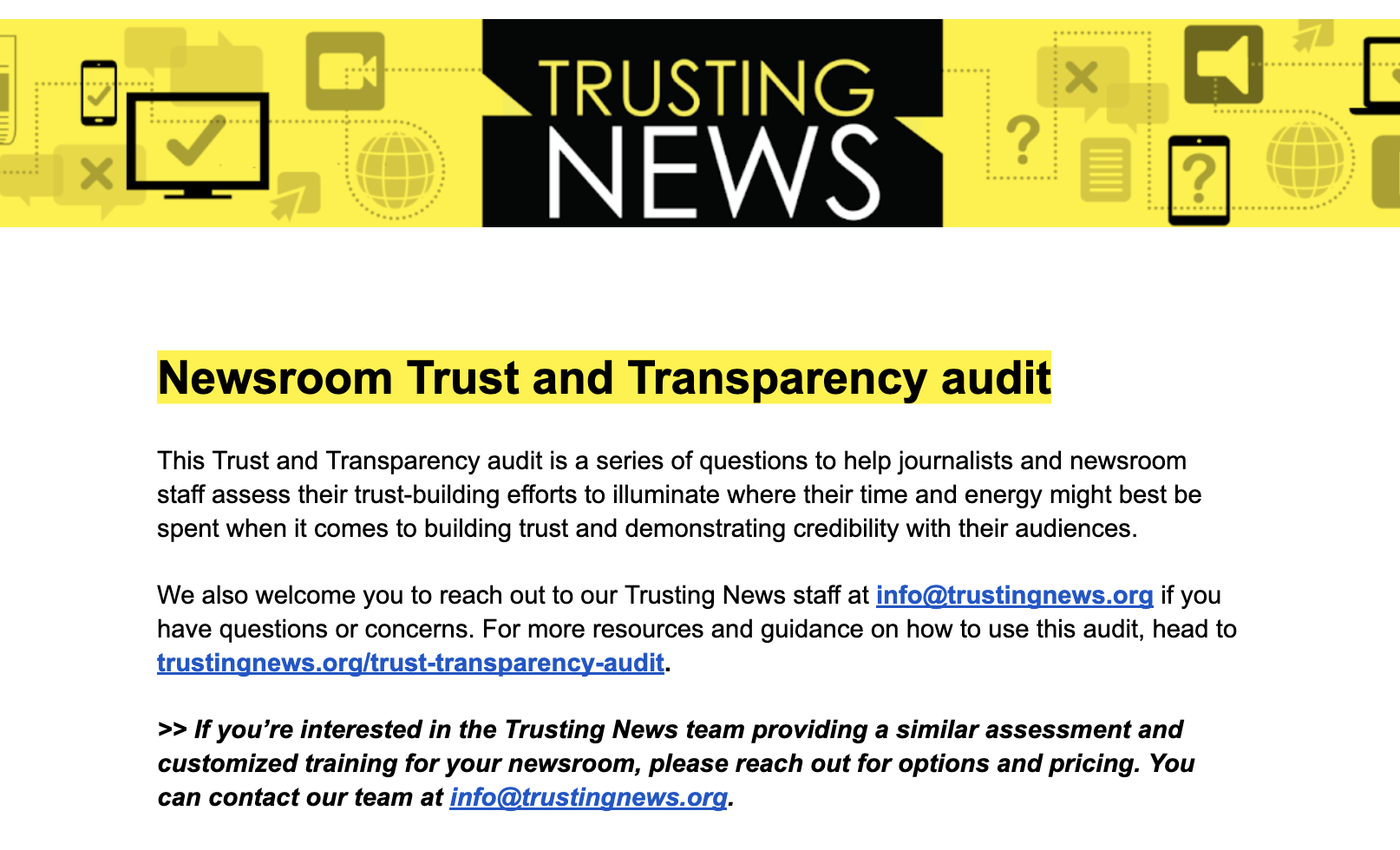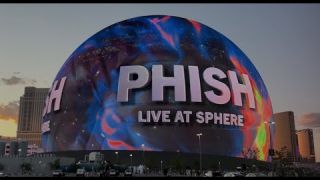"Because Science" Can Be a Dangerous Argument - Here's Why — Mickey Z.
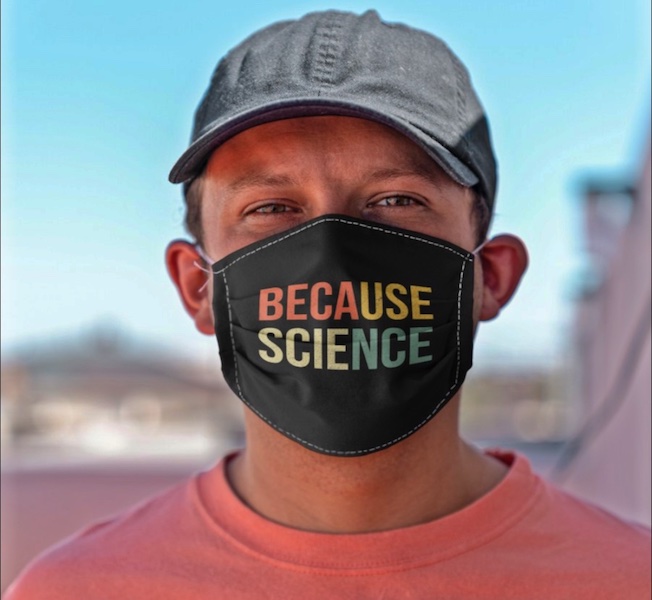
Screenshot from teechip.com
Mickey Z. — World News Trust
January 8, 2021
“Science never solves a problem without creating ten more.”
(George Bernard Shaw)
This article is not any of the following:
- “Anti-science”
- Conspiracy theory (in the way that term is most commonly used)
- Oblivious to that fact I’m writing it on a computer and you’re reading it in the ether
- Oblivious to the incalculable positive contributions of science and technology
- A conscious personal attack on anyone… except the criminals cited herein
This article is my attempt to offer a counterbalance to the general consensus that “science” is the ultimate indicator of one’s intelligence. I invite you to read on but, if hearing my thoughts on topics like science (or politics or social issues, etc.) makes you uncomfortable or angry, please — by all means — feel free to skip this one. There’s no reason for you to get stressed over it and/or decide you no longer like me because we don’t see eye to eye on a few issues.
And let’s be radically honest here: What you and I think about a subject like science has ZERO impact on how it exists in the real world. This is merely a contemplation on the subject — a contemplation rigorously backed with science’s favorite tool: verifiable evidence.
***
2020 was not a banner year for nuance. This includes the vaunted “Because Science” crowd. These folks will seemingly accept anything uttered by a man in a white coat. It got to the point that if they wanted to win an argument, they’d simply label their own evidence as “science” thus (in their minds), squashing all debate. Claiming to be on the side of science is enough to discount any differing viewpoints because, well… science. Anyone who doesn’t march in lockstep is obviously a moron or (gasp) a conspiracy theorist.
This article will be radical, in that it addresses the pro-science perspective at its very root: Is “science” worthy of the cult built around it? To try answering that query, I could talk about any one of the countless gifts bestowed upon us by science over the years. Let’s commence with perhaps the two biggest, most enduring paradigms: Why were women categorized as inferior, thus laying the groundwork for centuries of still-thriving patriarchy? Because science. Why did we first separate humans by “race” and thus lay the groundwork for centuries of still-thriving white supremacy? Because science.
Particularly relevant to today’s headlines: Why are approximately 4,500 drugs and medical devices recalled and pulled from shelves each and every year despite being approved by the U.S. Food and Drug Administration (FDA)? Why is "medical error" a top-three cause of death each year in the U.S.? Because, of course, science.
The list of specious scientific achievements (sic) is long enough to warrant a ten-part Netflix series. It includes, for example, the Tuskegee Study, mercury fillings, chlorofluorocarbons (CFCs), veal crates, electroshock therapy, napalm, mustard gas, automatic weapons, sonic weaponry, directed energy weapons, weapons in general, surgical experiments (without anesthesia) on slaves, deforestation, Vioxx, DDT, eugenics, GMOs, tar sands, fracking, fossil fuels, the Milgram experiments, factory farming, the medicalization of the birthing process, vivisection, mountaintop mining, MK ULTRA, conversion therapy, Love Canal, chimeras and hybrids, Avengers movies, forced sterilizations, pre-frontal lobotomies, waterboarding, deep-sea bottom trawling, Accutane, land mines, asbestos, and the electric chair— to name but a few of the innumerable options.
And I haven’t yet mentioned television, cellphones, automobiles (and automobile culture), the Internet, social media, and artificial intelligence!
If you’ve fallen in love with scientists, by all means, please allow me to introduce you to Chester M. Southam. In 1952, he injected unknowing inmates at the Ohio State Prison with live cancer cells. Eleven years later, he did the same to 22 elderly patients at the Jewish Chronic Disease Hospital in Brooklyn. Why would a man of science do such a thing? Simple, he wanted to “discover the secret of how healthy bodies fight the invasion of malignant cells.” Despite a cover-up, Southam’s atrocities were exposed and he was given the harsh punishment of (wait for it) one-year probation. By the late 1960s, the American Cancer Society elected him their vice president.
The because-science hive mind should also be enamored with University of Iowa researchers Wendell Johnson and Mary Tudor — creators of what is now known as the “Monster Study.” In 1939, Johnson and Tudor conducted an experiment on 22 orphan children. One group was given positive speech therapy. The others got negative speech therapy. Using science as their guide, the researchers left the negative group with speech problems they retained for the rest of their lives.
Who doesn’t appreciate the doubly dubious intersection of science and the military? A fine example occurred in 1956 and 1957 when the U.S. Army released millions of infected mosquitos into the cities of Savannah, Georgia and Avon Park, Florida. Their “scientific” goal was to see if the insects would spread dengue fever and yellow fever — and what a success! Hundreds of unknowing civilians presented with respiratory problems, stillbirths, fevers, encephalitis, typhoid, and death.
Ladies, do you know what textbook your obstetrician used in medical school? Perhaps it was “Medical, Surgical, and Gynecological Complications of Pregnancy” — written in 1961 and still available online here. This text warns future doctors how “dangerous” those female patients “who consider themselves ‘socially aware’” are. That type of woman is “not necessarily more mature but are trying, by their active interest in everything ‘avant-garde,’ socially as well as medically, to persuade themselves and others that they are…This is the patient who is interested in such methods as ‘natural childbirth,’ hypnosis, of using childbirth as an ‘experience’.” Such a woman, according to science, “requires close and constant psychiatric support.”
And, if science is your fetish, you’ll certainly love what researchers at Harvard University did in the late 1940s. They tested diethylstilbestrol, a synthetic estrogen, on pregnant women — without their knowledge — at the Lying-In Hospital of the University of Chicago. This scientific wizardry resulted in an abnormally high number of miscarriages and babies with low birth weight. But, hey, to question the white lab coats responsible would be tantamount to ignorance, right?
I could go on... and on. Despite my opening caveats, I can already hear all the knee-jerk complaints about how I’m conveniently ignoring the myriad benefits of science. Let’s be clear: You don’t need me to laud scientific accomplishments. That already happens, 24/7, across all forms of media, in textbooks, and in everyday conversation. As stated above, what we do need is some context and nuance and balance.
For the sake of this article, I’ll focus on something Senator Brien McMahon of Connecticut, in 1945, called “the most important thing in history since the birth of Jesus Christ.” He was talking about one of science’s most notorious, expensive, deadly, and ongoing nightmares: atomic energy.
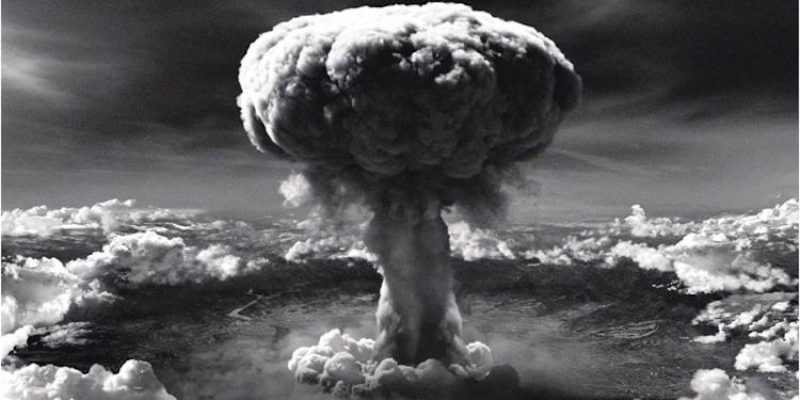
(public domain)
The ‘Second Coming’ arrived during the Second World War when it was baptized in the blood of 210,000 Japanese citizens. The death count across the globe in the ensuing decades remains incalculable, whether it be from direct radiation poisoning, the misuse of nuclear medicine, the diversion of funds to support the arms race, weapons like deleted uranium shells, or sadly predictable power plant disasters at places like Three Mile Island, Fukushima, and Chernobyl. Today, with the problem of reprocessing, recycling, or storing nuclear wastes still looming, it is nearly impossible to assess the extent of the future damage that will be wrought from the radioactive flames of Hiroshima and Nagasaki.
Before the bodies could be buried in Japan, the burgeoning nuclear industry teamed up with the world of public relations to make certain that the general public’s perception of the mighty atom would ensure a steady supply of U.S. tax dollars in the name of “science.” Between 1940 and 2020, the total amount of money (in today’s dollars) spent by the U.S. on nuclear weapons and weapons-related programs is at least $6 trillion (that we know of). One of the compliant and complicit media men chosen to cover/promote the Manhattan Project was William L. Laurence, a science reporter for the New York Times since 1930. Spinning stories of the “atom’s redemptive role,” Laurence swooned over nuclear research, calling it “comparable only with the biblical genesis.”

Photo: Thinkstock
To demonstrate a tiny fraction of the shameful “scientific” legacy of the U.S. nuclear industry, let’s start by examining the Hanford Reservation in Washington State, where the plutonium for the Nagasaki bomb was created in 1943. Thanks to poor planning, says noted activist and author, Dr. Helen Caldicott, 60 percent (by volume) of the nation’s highly radioactive, dissolved high-level waste from reactor fuel is now stored in “corrosive-prone, single-walled, one-million-gallon carbon steel tanks sunk in the desert floor.”
Sixty-six of the 149 tanks have leaked and at least 750,000 gallons of liquid high-level waste have entered the surrounding soil. As a result of this and other leaks (including those from the six Polaris submarines buried at Hanford and the irradiated fuel sent there from Three Mile Island), the nearby Columbia River is being fed by groundwater contaminated with uranium, strontium 90, iodine 129, and plutonium.
“In fact,” says Caldicott, “this beautiful river has been designated one of the most radioactive in the world, yet people still catch and eat fish without protection or warnings about health dangers.” Hanford is described now by Caldicott as “America’s nuclear cemetery — a vast dead satanic area, poisonous for millions of years.”
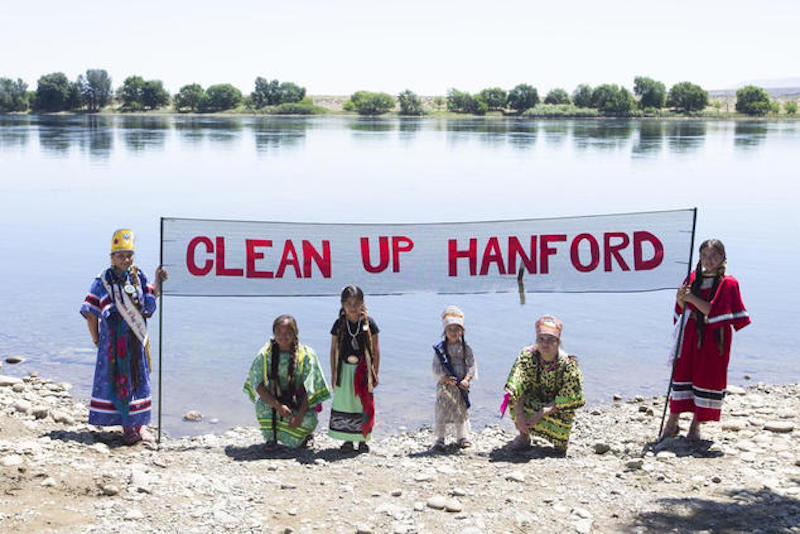
Hanford Journey 2019: Yakama Nation swan dancers by the Columbia River (Evan Abell/Yakima Herald-Republic)
The early scientific testing of nuclear technology took place in the continental United States and the subsequent fallout created a new breed of American: the downwinder. Documentarian and photographer, Carole Gallagher is the author of American Ground Zero: The Secret Nuclear War. In her book, she serves up an oral history of those U.S. residents who experienced the fallout from the many atomic and hydrogen bombs that were exploded right here in the Land of the Free™— including 126 tests at the Nevada Test Site.
“The entire state of Utah was irradiated along with most of the other Western states,” Gallagher explains. “The radiation was also carried by winds to the Northeast, all over the U.S. in fact … I do not know where we found the arrogance to call the Soviet Union ‘the Evil Empire,’ but I do recall the words of the town mortician in St. George, Utah, who used to embalm the tiny wasted bodies of children who had died from leukemia: ‘They done to us what the Russians couldn’t do.’”
As one Air Force colonel who monitored nuclear fallout throughout the U.S., Canada, and Mexico told Gallagher: “We are all downwinders.”
With the globe now anointed with an ample dose of atomic aromatherapy, one might accept the excuse that nuclear scientists simply did not know of the lethal side effects of radiation during the early post-war era. However, in late 1993, when then-Energy Secretary Hazel O’Leary released documents about secret nuclear experiments on American citizens, that alibi was no longer big enough to hide behind.
Immediately after Hiroshima and Nagasaki, nuclear researchers set about, at any cost, to discern the effects of plutonium on the human body. “In experiments worthy of Dr. Mengele,” wrote investigative reporter, Jack Bradigan Spula, “these researchers chose unwitting patients who were not expected to live long anyway.”

Josef Mengele at Auschwitz in 1944 (public domain)
“There were two kinds of experiments,” explains Peter Montague, director of the Environmental Research Foundation. “In one kind, specific small groups (African-American prisoners, mentally retarded children, and others) were induced, by money or by verbal subterfuge, to submit to irradiation of one kind or another. In all, some 800 individuals participated in these ‘guinea pig’ trials. In the second kind, large civilian populations were exposed to intentional releases of radioactive isotopes into the atmosphere.”
The corporate media response to these revelations in 1993 was as to be expected. For example, Newsweek had this to say about the 204 unannounced nuclear explosions and hundreds of experiments on humans: “The scientists who had conducted those tests so long ago surely had rational reasons: the struggle with the Soviet Union, the fear of imminent nuclear war, the urgent need to unlock all the secrets of the atom, for purposes both military and medical.” tl;dr: Because science.
Despite media acquiescence, these vile experiments cannot genuinely be dismissed as a momentary lapse amidst a well-intentioned, post-“Good War” paranoia. The declassified scientific documents on U.S. radiation experiments stretch three miles long.
Finally, for now, science has created the still-present specter of nuclear annihilation. Here’s how the Union of Concerned Scientists explains it:
“Despite the Cold War ending decades ago, the United States and Russia still keep hundreds of nuclear weapons on high alert, ready to launch. Also known as ‘hair-trigger alert,’ this rapid launch option significantly raises the risk of an accidental, unauthorized, or mistaken nuclear attack, with no appreciable benefits to national security.
“On its surface, the system is simple: if we detect and verify a nuclear attack, we’ll launch our own missiles before they’re destroyed. But the process must occur within minutes and relies heavily on error-prone radar, satellite, and human communication systems, all of which are susceptible to false alarms and, potentially, cyberattack. And because the timeframe is so short, the military depends on scripted nuclear launch procedures that are routinely rehearsed, biasing the process toward a decision to launch — especially in times of crisis. From faulty computer chips to simple human mistakes, dozens of near misses and safety accidents illustrate these and other shortcomings.”
***
As I sit in New York City writing this, I am reminded that the Indian Point nuclear reactor is only 35 miles from the center of Manhattan and, as Helen Caldicott details, “A meltdown would trap millions of people in a radioactive hell, unable to escape, dying within 48 hours of acute radiation illness. Such an event is not unlikely according to the Nuclear Regulatory Commission, because this reactor is plagued with safety problems.” Why? Because science, of course…
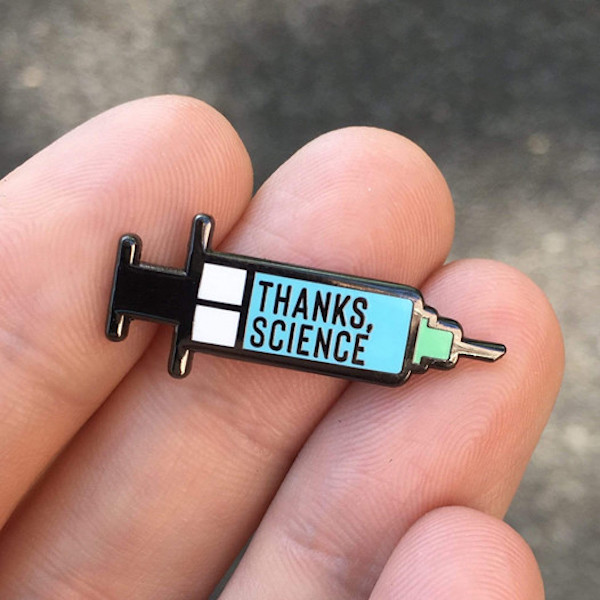
Image found on Facebook
Within a global culture founded on the un-holy trinity of patriarchy, white supremacy, and capitalism, every official effort — in any sphere — must be judged through those lenses. Science does not exist in a vacuum. It is a product of this society, much like art, politics, religion, philosophy, or pop culture. All of these entities are shaped by the norms imposed upon them. On one level, you could say science is as good or bad as the people (usually men, usually white men, usually affluent white men) funding it and profiting from it. However, this is not to say that science — or its kissing cousin, technology — is inherently “neutral.”
Make no mistake: science and technology are definitely not neutral. Among other negative outcomes, science and technology spawn:
Toxic Waste/Environmental Racism
A record 53.6 million metric tons of electronic waste was generated in 2019. At most, only 20 percent is formally recycled. Seventy percent of the entire toxic waste stream of landfills is e-waste. While the developed world quenches its insatiable thirst for the newest and latest gadget, much of the subsequent e-waste is exported to countries like India, Pakistan, Nigeria, and Ghana. "The pollution and related health problems in countries where e-waste is dumped will increase massively as the amount of electronics used worldwide is growing exponentially and the number of countries used as dumpsites will grow," says Kim Schoppink, Toxics Campaigner at Greenpeace.
Environmental Destruction
Thanks, for example, to the aforementioned automobile culture, in the 20th century, an area equal to all the arable land in Ohio, Indiana, and Pennsylvania was paved in the U.S. This means highways, off-ramps, parking lots, etc. — each uprooting countless, essential eco-systems. As it’s been said, we live in a world in which a tree is worth more dead than alive. Capitalist science makes this a reality. I could easily expand this “environmental destruction” section into a book of its own but will sum up now as such: To extoll the “because science” virtues of modern technology, we must studiously ignore the apocalyptic ecological price being exacted.
Inequality
As you scroll for hours on your phone, ponder this: Roughly half of the humans on the planet do not have internet access. But well beyond memes and flame wars, do you ever stop and wonder if access to electricity is a universal reality on Earth? In the African nation of Burundi, science has only managed to help equip 11 percent of residents with electricity. Here are some other numbers:
- Burkina Faso: 14.4 percent of the population has access to electricity
- Mozambique: 31.1 percent
- The Democratic Republic of the Congo: 19 percent
- Haiti: 45.3 percent
- Malawi: 18 percent
- Niger: 17.6 percent
- Liberia: 25.8 percent
- Chad: 11.8 percent
- Low-income nations, in general: 41.1 percent
Meanwhile, according to UNICEF, one in seven of the world's children had no access to safe water. As a result, contaminated drinking water is estimated to cause 485,000 diarrheal deaths each year. This includes more than 800 children under age 5 dying per day. Every 19 seconds a child dies from a water- and/or sanitation-related disease. It seems “science” is not meant for everyone.
Alienation and Submission
We may have social media but we've sacrificed social skills. "With the present means of long-distance mass communication, sprawling isolation has proved an even more effective method of keeping a population under control, henceforth a one-way world," wrote historian, Lewis Mumford. In other words, corporate science and technology are a lot more than telegenic celebrities like Bill Nye and Neil deGrasse Tyson. It’s a complex system that by its own design involves far-reaching negative aspects like:
- Resource extraction
- Economic exploitation
- Division of labor
- Alienation and isolation
- Media manipulation
- Submission to social hierarchies
- Discrimination based on sex, race, ability, class, and more
All of the above elements are baked into what corporate science and the corporate media markets to us. You cannot honestly declare “because science” without including these factors and the long, sordid history of scientific atrocities. It’s a package deal. Even if placed into the hands of saints, modern science and technology would intrinsically wreak environmental, economic, psychological, social, and spiritual havoc.
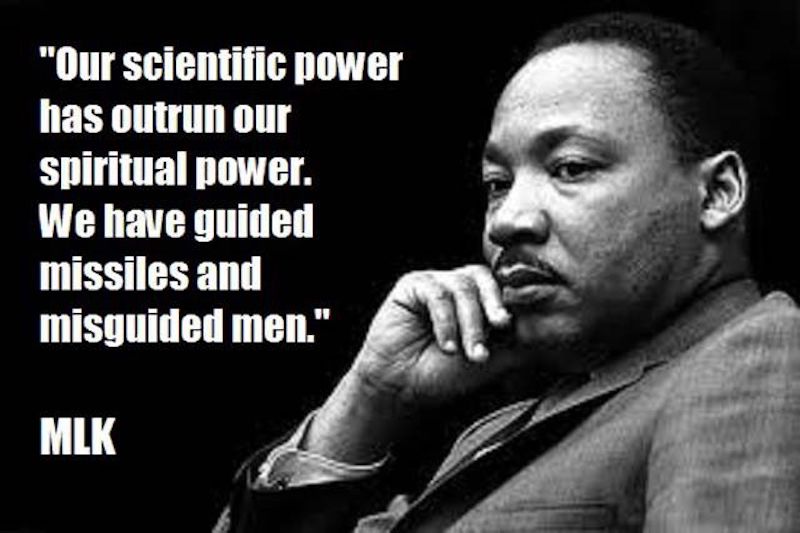
Screenshot from Pinterest
To repeat what I said up top: Obviously, science can and does contribute to many positive and even life-saving developments. But, I’m talking about corporate science, not 10th-grade chemistry lab. Corporate, profit-driven science has been and will always be responsible for reprehensible outcomes. Breaking news: The phrase “because science” lacks any useful meaning in the real world. In a theoretical sense, science can indeed look and feel like a refuge for the logical and fair-minded among us. But we don’t dwell in a textbook world; we live in a messy and divided culture.
The phrase “because science” is a prime example of black-and-white thinking. Like everything else we are forced to navigate in modern life, science does not deserve the benefit of the doubt. Skepticism is always warranted. Skepticism, in fact, might be our only form of self-defense. Step away from your news feeds and give your mind space to formulate independent thoughts. “Because science,” as a credo, is not an example of critical thinking. “Because science” is as useful as “because politics” or “because religion” or “because culture” or “because tradition” and so on.
We are being willfully manipulated by those who stand to profit from such manipulation. They use artificial intelligence (more science) to easily outsmart us. It’s hard to accept but none of us is immune to such a well-crafted trap. To believe we have not been manipulated is as realistic as declaring we’re not subject to weather patterns or the laws of gravity. Being a victim of targeted manipulation is not a judgment of us or our intelligence. It’s a statement on the dystopian world in which we all live.
***
I’ll close with a question for those who identify as part of the “because science” crowd: What was it like to read this article? Oftentimes, when we encounter new information or a fresh viewpoint that differs from ours, we respond to it based on how it makes us feel. If the facts I shared made you angry, fine. But are forming your opinion of this article (and perhaps me) based on that anger? If so, I request that you catch yourself before emotion overwhelms reason. This is the kind of self-awareness work I’ve been struggling with and I invite you to join me in such a Sisyphean pursuit. But either way, I’ll close with this reminder: The accuracy of a fact is never dependent on how it makes you feel. Any half-way decent “scientist” could tell you that…
Mickey Z. can be found here. He is also the founder of Helping Homeless Women - NYC, offering direct relief to women on the streets of New York City. To help him grow this project, CLICK HERE and make a donation right now. And please spread the word!
- CreatedFriday, January 08, 2021
- Last modifiedWednesday, October 06, 2021
World Desk Activities
www.niemanlab.org/2024/04/inside-newsweek-ai-exper…
www.journalismfestival.com/programme/2024/reader-r…
Reader revenue beyond the English language – – International Journalism Festival
In the past few months, many news publishers in the US have announced layoffs. Others have tweaked or abandoned their paywalls and pursued more open models.…
phys.org/news/2024-04-surf-clams-coast-virginia-re…
Surf clams off the coast of Virginia reappear and rebound
The Atlantic surf clam, an economically valuable species that is the main ingredient in clam chowder and fried clam strips, has returned to Virginia waters…
medicalxpress.com/news/2024-04-antibiotics-reveal-…
Antibiotics reveal a new way to fight cancer
Cancer cells grow and spread by hiding from the body's immune system. Immunotherapy allows the immune system to find and attack hidden cancer cells, helping…
phys.org/news/2024-04-crucial-quantum-internet.htm…
Crucial connection for 'quantum internet' made for the first time
Researchers have produced, stored, and retrieved quantum information for the first time, a critical step in quantum networking.
medicalxpress.com/news/2024-04-women-major-complic…
Women who experience major complications during pregnancy found to have increased risk of early death years later
A team of medical researchers from the University of Texas Health Science Center, in the U.S., and Lund University, in Sweden, has found via study…
medicalxpress.com/news/2024-04-common-hiv-treatmen…
Common HIV treatments may aid Alzheimer's disease patients
Alzheimer's disease (AD) currently afflicts nearly seven million people in the U.S. With this number expected to grow to nearly 13 million by 2050, the…
medicalxpress.com/news/2024-04-adolescent-stress-p…
Study suggests adolescent stress may raise risk of postpartum depression in adults
In a new study, a Johns Hopkins Medicine-led research team reports that social stress during adolescence in female mice later results in prolonged elevation of…
Latest Stories
Electronic Frontier Foundation
- Speaking Freely: Obioma Okonkwo April 23, 2024
- Screen Printing 101: EFF's Spring Speakeasy at Babylon Burning April 23, 2024
- Podcast Episode: Right to Repair Catches the Car April 23, 2024
- U.S. Senate and Biden Administration Shamefully Renew and Expand FISA Section 702, Ushering in a Two Year Expansion of Unconstitutional Mass Surveillance April 22, 2024
The Intercept
- “Tell the World What’s Happening Here,” Say Patients in Gaza April 26, 2024
- “Little Home Market”: The Connecticut Company Accused of Fueling an Execution Spree April 25, 2024
- House Responds to Israeli-Iranian Missile Exchange by Taking Rights Away from Americans April 25, 2024
- U.S.-Trained Burkina Faso Military Executed 220 Civilians April 25, 2024
VTDigger
- Brianne Goodspeed: VTDigger’s story on the sale of Chelsea Green lacked depth and perspective April 26, 2024
- Liz Medina: ‘Same old rich man strategy’ used to oppose workers’ rights — with a new twist April 26, 2024
- Final Reading: New USDA program aims to help towns access federal disaster relief April 25, 2024
- Vermont’s new fair and impartial policing policy aims to reduce bias based on citizenship April 25, 2024
Mountain Times -- Central Vermont
- Mountain Times -Volume 52, Number 17, April 24-20, 2024 April 24, 2024
- Weekly Horoscope — April 24-30, 2024 April 24, 2024
- Loon vs. Canada goose: A battle for Goose Poop Island April 24, 2024
- A break in the action April 24, 2024

